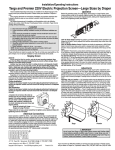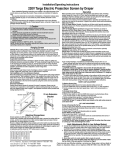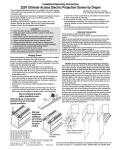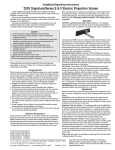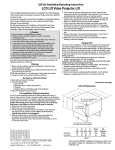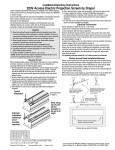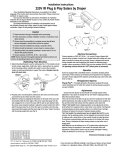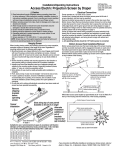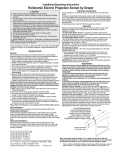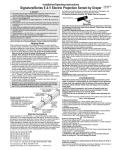Download Draper 130030 projection screen
Transcript
Installation/Operating Instructions Baronet/HW 110V and 220V Electric Projection Screen by Draper These Installation/Operating Instructions are available in the official language of the country where you purchase the product. Please contact your distributor to request a copy. Vous pourriez demander les instructions d’installation et d’opération traduises dans la langue officielle du pays ou vous achetez le produit. Veuillez demander à votre distributeur. Die Gebrauchsanweisung für Installation und Konstruktion sind in der offiziellen Sprache des Landes, indem Sie das Produkt gekauft haben, vorhanden. Fragen Sie die jeweilige Verkaufs-Abteilung. Caution ➀ Read instructions through completely before proceeding. ➁ Follow instructions carefully. Installation contrary to instructions invalidates warranty. ➂ Screen should be accessible for complete removal should fabric become damaged or should other service be required. ➃ Screen should be installed level (using a carpenter’s level). ➄ Nothing should be fastened to screen dowel or viewing surface. ➅ Operating switch(es) packed separately in screen carton. Do not discard with packing material. ➆ Screen operates on 110-120V AC, 60 Hz. or 220V AC, 50 Hz. current, depending on model ordered. NOTE: Screen has been thoroughly inspected and tested at factory and found to be operating properly prior to shipment. Hanging Screen Back hole for wall mounting. Hardware by others. Crimp Crimp Electrical Connections Screen operates on 110-120V AC, 60 Hz./220V AC, 50 Hz. current, depending on model ordered. Duty Cycle: On 26 seconds/off 3 minutes. Junction box is located inside left endcap and cover plate is secured to endcap with two screws. Junction box contains pigtail leads and grounding screws, per wiring diagram on reverse. Screen is shipped with internal wiring complete and control switch(es) fully boxed. Wire connecting screen to switch(es) and switch(es) to power supply should be furnished by installer. Connections should be made in accordance with attached wiring diagram, and wiring should comply with National and local electrical codes. All operating switches should be “off” before power is connected. Do NOT wire motors in parallel. Operation General: When locating viewing surface and checking clearance for screen’s operation, remember surface is centered in case. Handle case carefully to protect its finish. Regardless of mounting method, screen should be positively and securely supported so that vibration or even abusive pulling on the viewing surface will not cause case to work loose or fall. Installer must insure that fasteners used are of adequate strength and suitable for mounting surface chosen. Suspended Installation: Suspend screens from holes in top of endcaps as shown. "S" hooks, chains (or cable) and turnbuckles should be provided by installer. “S” hooks should go through the front holes on the endcaps (see drawing below), and both ends of the “S” hooks should be crimped for additional safety. Chains should be attached to beams or other structural members. Turnbuckles should be adjusted so screen hangs level. Mounting angle and hardware by others. Suggested for recessed installations. Wall Installation: Mount screen through holes in back of endcaps as shown. Installer should furnish appropriate hardware as required. Recessed Installation: Recess should permit access for removal of screen if necessary. Screen may be mounted as in suspended or wall installation. Angles may be used (provided by others). Top Hole for suspended mounting. Hardware by others. Before operating screen remove tape securing fabric and dowel to roller. If viewing surface hangs out of case 8" or 9" (20-23 cm), tape has probably been broken by rough handling in shipment, allowing surface to “unwrap” one turn about the roller. Manually wrap fabric back around the roller without turning the roller itself. 110-120V/220V Single Station Control — 3-position up-off-down switch permits operation to be stopped at any point. Factory adjusted limit switches automatically stop screen when fully down or fully up. 220V version is CE certified. 110-120V/220V Multiple Station Control—Switches are similar in appearance to 110V/220V Single Station Control. Screen stops when switch is released and may be restarted in either direction. Factory adjusted limit switches stop screen automatically when fully up or fully down. 24V Control — Three-button up-stop-down switches stop at any point desired, operate in any sequence. Factory adjusted limit switches automatically stop screen when fully up or fully down. Key Operated Switching — Two kinds of key-operated switches are optionally available with this unit. ➀ The key-operated power supply switch controls power to the screen and switches. When it is “off ”, the switches will not operate screen. Key may be removed from the switch in either “on” or “off” position. ➁ A three-position key switch permits the screen to be operated directly by key. In this case, the screen’s operator must always have a key. RS232/Ethernet—Serial communication and network communication optionally available with wall switches, RF or IR remote. Adjustments Minimum 5 cm wide slot for passage of viewing surface if suspended above ceiling Example of suspension above ceiling. Ceiling tile and grid (by others) ® Screen has been factory set and should not normally require further adjustment. However, if you desire to change the “up” and “down” stopping positions, proceed as follows: “Down” limit switch: Down stopping position can be adjusted by turning white knob with a screw driver or hex wrench. Turning knob counterclockwise will allow viewing surface to run farther down. Turning it clockwise will reduce the amount of exposed viewing surface. “Up” limit switch: Up stopping position can be adjusted by turning red knob with a screw driver or hex wrench through the small grommet. Turning knob counterclockwise will allow surface to run farther into screen case. Turning it clockwise will allow viewing surface to stop farther out of screen case. CAUTION: Be sure all switches are in “off” position before adjusting limit switches. Always be prepared to shut screen off manually when new adjustment is being tested. Screen may be severely damaged if viewing surface is allowed to run too far up or too far down. Baronet/HW 110-120V AC version is certified by Underwriters’ Laboratories, Inc., for the U.S. and Canada. Copyright © 2010 Draper Inc. Form BaronetHW_Inst10 Printed in U.S.A. Baronet/HW220V AC version is CE certified. If you encounter any difficulties installing or servicing your Baronet/HW screen, call your dealer or contact Draper, Inc., Spiceland, Indiana, +1 765-987-7999 or fax +1 765-987-1689. Baronet/HW by Draper Page 2 of 2 Case Dimensions 3¼" (83 mm) Fabric width + 5¾" (146 mm) 3¼" (83 mm) 3¾" 96 mm Viewing Surface Wiring Diagrams Please Note: Do not wire motors in parallel. Baronet/HW 110V AC Baronet/HW 220V AC (CE) Multiple Station Control Single Station Control Junction box at left end of screen Junction box at left end of screen Single Station Control Junction box at eft end of screen Internal Screen Wiring White (Common) Black (Down) Red (Up) Green (Motor Ground) Internal Screen Wiring White (Common) Black (Down) Red (Up) Green (Motor Ground) Junction box at left end of screen CE Approved Multiple Station Control Not CE Approved Internal Screen Wiring Blue-220v (Common) Brown-220v (Down) Black-220v (Up) Internal Screen Wiring Blue-220v (Common) Brown-220v (Down) Black-220v (Up) Green (Motor Ground) Green (Motor Ground) Control switch Single gang box by others Min. 4" x 2-1/8" x 1-7/8" deep Blue Red Black Red Blue Black Blue Control switch Black Blue Single gang box by others Min. 4" x 2-1/8" x 1-7/8" deep. 3 shown. More or less equally feasible. Dashed wiring by installer Black Red Dashed wiring by installer 220v, 50 Hz. To 110V AC Line Low Voltage, IR Remote or RF Remote (LVC-III) MC1 Internal Screen Wiring White/Blue (Common) Red 110/Black 220 (Up) Black 110/Brown 220 (Down) Green 110V/ Green/Yellow 220V (Motor Ground) White or Blue-Common to screen & 110/220V AC Neutral Red-to screen (directional) Brown-to screen (directional) Yellow-to 110/220V AC-Hot Black-to 110/220V AC-Hot Green(Ground) Dashed wiring by electrician Low voltage wiring by others Eye Port for IR Eye, RF Receiver or LED Wall Switch. For more than one of these, a splitter is required. 3 Button Wall Switch DOWN - Black COM - White UP - Red See separate Serial Communication-RS232 Instruction sheet for enabling RS232 with the MC1. Internal Screen Wiring To 110/220V Line Program LED White or Blue-Common Red-to Screen (directional) Black-to Screen (directional) Brown-Hot to AC Green/Yellow-Ground White/Blue (Common) Red 110/Black 220 (Up) Black 110/Brown 220 (Down) Green 110V/ Green/Yellow 220V (Motor Ground) STOP STOP Location of key operated on-off switch if furnished RS232 Data FROM Control System RS232 Data TO Control System Signal Ground & Manual Switch Common Manual Switch Down Manual Switch Up MC1 110-120V 3-Position Wall Switch Low Voltage Wiring by others AC Wiring by electrician Fuse Control Switches 24v DC Aux Port for connecting additional LVC-III modules (up to six total can be linkedconnect from Aux to Eye). Location of key operated on-off Eye Port for IR Eye. For RF Receiver or LED switch if furnished Wall Switch, a Splitter and a Power Supply is required. Plug RF Receiver or LED Wall Switch and Power Supply into splitter, then run cable from Splitter to MC1 Eye Port. To AC Line 220V 3-Position, Surface Mount Wall Switch 3.8mm (1 1/2") 7mm (23/4") 4.5mm UP Blue Black 220v, 50 Hz. Location of key operated on-off switch if furnished Neutral Red Blue Hot Black Red Neutral Red To 110V AC Line Blue Red Dashed wiring by electrician Black Location of key operated on-off switch if furnished Cap off with wire nut & tape Cap off with wire nut and tape L1 Dashed wiring by electrician (1 3/4") 3.2mm (1 1/4") 3"-6" leads 11.8mm (41/2") 8.6mm (33/8") DO W N www.draperinc.com (765) 987-7999 7.8mm (31/16")


